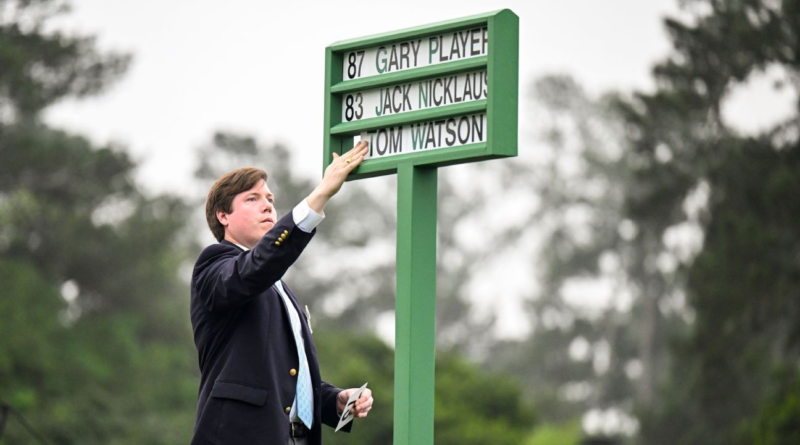Masters ceremonial tee shot is a bridge between what was and what's to come
AUGUSTA, Ga. — IN ONE OF the strangest rituals in sports, which serves as a meta skeleton key to understanding the Augusta National Golf Club, three old men dressed in a quiet locker room to hit a ceremonial tee shot. Huge crowds of people waited for them down below, stacked five and six deep, from the big tree down to the middle of the first fairway. Members in green jackets huddled with cups of coffee on the clubhouse veranda.
The murmurs started.
“There’s Jack.”
“Jack!”
The most beloved golfer on the course, Jack Nicklaus, had arrived, beloved despite not hitting a meaningful shot in decades, beloved not in spite of his age but somehow because of it. He knew Bobby Jones. So did his friend Gary Player, who once had dinner with the old champion when Jones’ hands were so riddled with arthritis he couldn’t hold a dinner fork. He asked Player to wedge a fork in between his gnarled digits and, if he’d be so kind, to cut up his steak. Player did as he was asked and then tried to get some insight about how to birdie the impossible No. 3.
“You’re not supposed to birdie the third hole,” Jones told him solemnly.
These three men are a bridge that connects the old Masters, an insular southern rite of spring, with the new Masters, which at its heart is an experiment designed to discover, once and for all, if money can truly solve every problem. Tom Watson walked with them and all three golfers waited as the club chairman welcomed the crowd to another year.
It was first-light gray with the idea of blue visible in there, too. The air didn’t smell like cigar smoke yet. They all played their parts. Gary flexing and almost sneering for someone to challenge his physical prowess. Tom made a joke about wrecking a go-kart and Jack played the jester, which is what’s left now that his furious competitiveness has been tempered and cooled by age and scars.
I’d come out to the course early to see this — which I’m almost embarrassed to admit still moves me. Standing up on a little hill with a view of the first tee box, I wondered what was so captivating about seeing three old men hit a meaningless shot, which of course wasn’t meaningless, as demonstrated by our attendance. The ceremonial start keeps alive the unbroken line of succession from Bobby Jones to Ben Hogan to Arnie to Jack to Tiger. This bridge is the most load bearing part of the Masters.
Jack placed the ball on the tee and laced it out into the fairway.
He raised his arms in victory and the crowd laughed and the real golfers started making their way to the course. A few minutes later, the three men walked into a news conference room. There was a bit of a crowd for that early in the morning.
“Good gracious,” Jack said. “I didn’t know anybody would remember us.”
They looked comfortable behind the microphones and could have talked all day. They told delightful stories about the past in such a way that made the membrane between then and now thin and then disappear. It was a nostalgic delight and central to the difference between this tournament and the other three majors.
The Masters works because of a nifty magic trick: One hand is all about tradition, and how the whims of modern sports’ 18-to-49-year-old demo hunt don’t apply here, while the other hand is doing nothing but changes, dozens of changes a year, to the course and the grounds and the parking lots and the hospitality spaces. The club has changed the grass on the greens, and the greens themselves. It ripped out the old Par 3 course and just built a new one. They invited Dude Perfect to film trick shots here last year. They hosted a video game tournament earlier this week in the press room. They sell collectible gnomes.
The club just added 35 yards to hole No. 13 in an attempt to make players hit 5-irons into the green. There are long-term construction plans, as detailed in the Golf Digest story that everyone here is talking about, and there is a time in the not so distant future when Augusta National will be a theme park. A high-end very well-run theme park. There’s talk of a hotel on the grounds. Once the Masters felt like the anti-big event, a parallel universe’s idea of what sports might be like without the sheen of business slathered on it. Now it feels like the Super Bowl of golf. They’re both a great time but very different ideas of the future and a reminder of how uncertain that future remains.
The singer-songwriter Jason Isbell talks a lot about how nostalgia is toxic and useless, and there’s so much of it in the air in Augusta that it can be blinding. The Masters is changing, a little more every year, because while the fans love to remember what it was, the people tasked with running it must always be looking to the future. That dichotomy has led this year to this sense of limbo. Will Tiger ever be Tiger again? Will Augusta lose its soul as it marches bravely into the future? What will happen to the LIV players? All of these things are works in progress, the destination over an unseen horizon.
Gary Player talked a little about uncertainty on Thursday morning, saying he knows every time he comes here now could be his last. He’s 86 years old. A lot of the questions he and his fellow old-timers got were about all those changes, to the course, to the greens, to the relationship between the PGA and LIV, and the proposed changes to the golf ball. People wanted them to look back over the long arc of their careers and use that perspective to predict the future. Mostly they stayed in the safe realm of funny, insightful stories about long-dead legends who can no longer speak for themselves. Gary, especially, loves to do that. On Thursday, he was telling a story about the co-founder of the Masters, Clifford Roberts, and riffing on how nothing ever stays the same and almost as an afterthought, he looked out at the room.
“Change is the price of survival,” he said.




